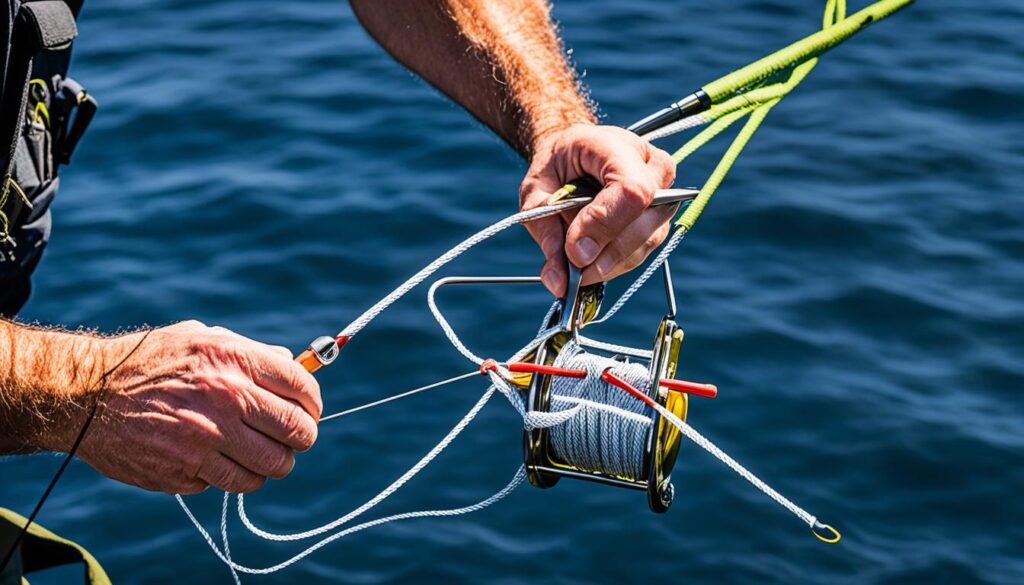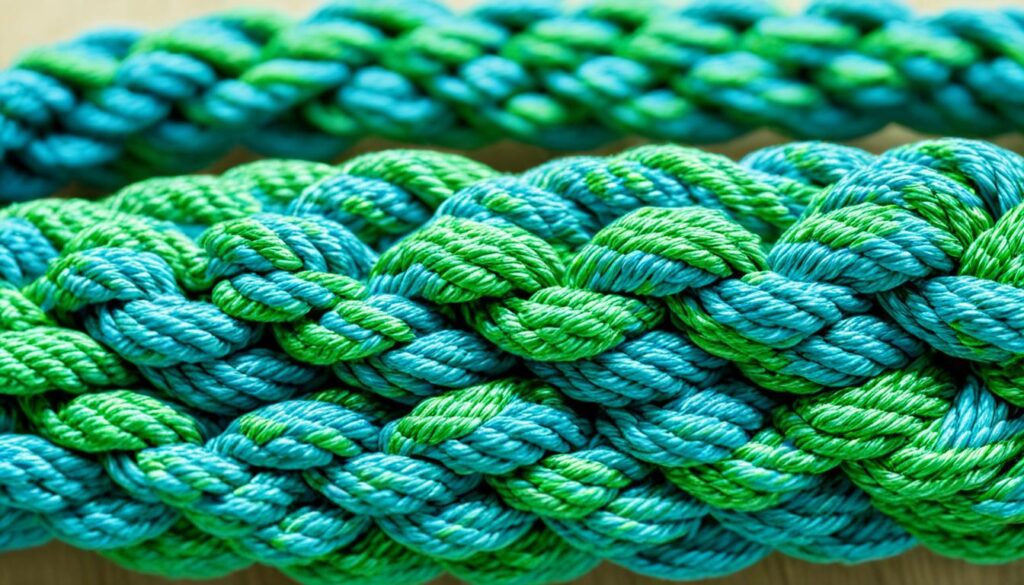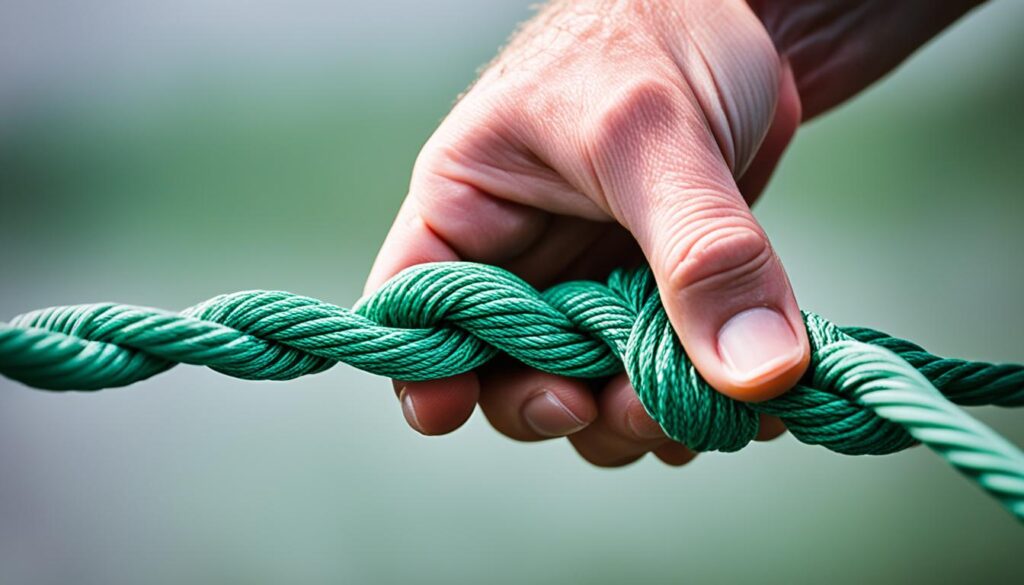Welcome to our comprehensive guide on mastering the Trilene Knot. Whether you’re a seasoned angler or just starting, learning this knot is essential for your fishing repertoire. Our step-by-step instructions will equip you with the skills to tie the Trilene Knot confidently and securely. With this knot in your arsenal, you’ll easily connect your line to hooks or swivels, ensuring reliable performance on your fishing adventures.
Understanding the Trilene Knot
The Trilene Knot is excellent for joining lines to hooks or swivels. It works well with both fluorocarbon and monofilament lines. It’s a strong knot, perfect for everyone who loves fishing.
Here is how to tie the Trilene Knot in a few easy steps:
- Start by passing the line twice through the eye of the hook or swivel.
- Hold the loop formed by the double pass with your thumb.
- Next, wrap the tag end of the line around the main line 5-6 times.
- Pass the tag end through the loop formed by your thumb.
- Moisten the knot with saliva to lubricate it.
- Gently pull on the tag end to tighten the knot.
Tips for Tying the Trilene Knot
Here are some essential tips for tying the Trilene Knot. First, could you make the wraps tight around the main line? This ensures the knot is strong and less likely to slip—second, wet the knot before tightening. Saliva or water reduces friction, making the knot tighten smoothly. Finally, it’s good to start with thicker lines. This gets you ready to use smaller or more delicate lines.

Advantages of the Trilene Knot
The Trilene Knot remains a preferred choice among anglers for several compelling reasons. Renowned for its exceptional strength, this knot stands firm against the formidable pull of large, fighting fish. Whether you find yourself locked in a battle with a trophy-sized catch or engaged in a spirited tug-of-war with a feisty opponent, rest assured that your prize remains securely tethered, courtesy of the Trilene Knot.
Furthermore, mastering the art of tying the Trilene Knot poses little challenge, making it an attractive option for anglers of all skill levels. Our user-friendly guide allows even novice anglers to swiftly acquire proficiency in executing this knot. Its straightforward yet dependable tying method ensures a seamless learning curve for all.
Additionally, the Trilene Knot boasts unparalleled security, ensuring that your line remains firmly affixed to your hook or swivel. This significantly diminishes the risk of slippage or breakage, providing peace of mind as you embark on fishing. With the Trilene Knot safeguarding your gear, you can confidently pursue that elusive “fish of a lifetime” without fear of equipment failure.

Common Mistakes to Avoid
While tying the Trilene Knot, it’s crucial to steer clear of common errors to ensure your knots’ utmost strength and reliability. Understanding and avoiding these pitfalls enhances the integrity of your knots and elevates your overall fishing experience. Let’s delve into the top mistakes to avoid:
- Inadequate Tightening of the Knot
One of the most significant blunders is failing to tighten the Trilene Knot adequately. A loosely tied knot compromises its strength and durability. Pull the tag end firmly to rectify this and achieve a tight, snug knot. A well-tightened knot provides the resilience to withstand the pressure of reeling in fish without succumbing to breakage.
- Neglecting to Moisturize the Knot Before Tightening
Another common oversight is neglecting to moisten the knot before cinching it down. Before tightening, it’s imperative to wet the knot with saliva or water. This simple act reduces friction during tightening, facilitating a smoother process. Additionally, moistening the knot prevents the line from weakening or fracturing under stress. Always ensure the knot is adequately lubricated before applying tension.
- Overlapping Wraps While Wrapping the Tag End
Avoid overlapping wraps when winding the tag end around the main line. Overlapping compromises the integrity of the knot, rendering it susceptible to failure. Instead, ensure each loop of the tag end lays adjacent to the preceding one in a tight, orderly fashion. This meticulous approach yields a robust knot that is resistant to unraveling during fishing expeditions.
By sidestepping these common mistakes, you can craft Trilene Knots of superior strength and reliability, indispensable for successful fishing endeavors. Please take your time, follow best practices, and remember to tighten the knot securely, moisturize it adequately, and avoid overlapping wraps. With these essential tips at your disposal, you’ll be well-prepared for any fishing excursion that comes your way.
Exploring a Variety of Fishing Knots
While the Trilene Knot is a favored option, many other knots are worthy of consideration. You’ll find the Palomar Knot, the Improved Clinch Knot, and the Uni Knot. Each knot boasts its unique strengths and weaknesses, prompting the need for experimentation to determine the most robust link between your line and hook.
Palomar Knot: Simple Yet Sturdy
The Palomar Knot offers simplicity and strength, contrasting with the complexity of the Trilene Knot. You can swiftly secure your connection by folding your line in half, threading it through the hook’s eye, and knotting it once. This knot excels with braided lines, retaining its resilience even in challenging conditions.
Improved Clinch Knot: Ideal for Delicate Configurations
The Improved Clinch Knot proves invaluable for joining thin lines to small hooks. By threading the line through the hook’s eye, wrapping it several times, and completing the knot with a loop, you achieve a firm grip ideal for light setups.
Uni Knot: Versatility and Reliability Combined
The Uni Knot, also known as the Duncan Knot, is a versatile solution for various fishing applications. Whether securing your line to hooks, lures, or swivels, this knot delivers unwavering strength and dependability. Creating loops around the line and threading the end through establishes a connection renowned for its robustness.
Selecting the Right Knot to Suit Your Fishing Style
When evaluating different fishing knots, consider factors such as strength, ease of tying, and applicability to specific situations. While the Trilene Knot offers versatility and stability for most applications, the Palomar Knot excels with braided lines, the Improved Clinch Knot proves ideal for delicate setups, and the Uni Knot emerges as a flexible choice. Choose the knot that aligns best with your fishing preferences and requirements.
Mastering Alternative Fishing Knots for Optimal Success
Familiarizing yourself with these alternative fishing knots equips you for any angling expedition. I’d like you to please dedicate time to learning and practicing these knots, as the right knot guarantees a secure connection between your line and hook, and it will increase your chances of landing your desired catch.
Comparison of Fishing Knots
| Knot | Strength | Difficulty | Applicability |
|---|---|---|---|
| Trilene Knot | High | Medium | Most fishing applications |
| Palomar Knot | High | Easy | Braided lines |
| Improved Clinch Knot | Medium | Easy | Light lines, small hooks |
| Uni Knot (Duncan Knot) | High | Medium | Various fishing applications |
Conclusion
Mastering the Trilene Knot is vital for all anglers. This guide has provided all the proper steps and tricks. So, whether you’re just starting or you’ve been at it a while, learning this knot well is essential.
Pull the Trilene Knot tight and wet it before tying it right. This ensures that your fishing line is very secure. Because of its strength, the Trilene Knot is an excellent pick for joining your line to hooks or swivels. This means you can fish without worry. The knot can handle the strong pull of fish.
No one gets it perfect at first. Keep at it to improve your Trilene Knot skills. Also, try out other fishing knots to see what works for you. With practice and mastery of the Trilene Knot, you’ll have a great time fishing.
FAQ
What is the Trilene Knot?
The Trilene Knot is great for tying fishing line to hooks or swivels. It’s both versatile and strong.
How do I tie the Trilene Knot?
First, pass the line through the hook’s eye twice. Now, hold the loop with your thumb. Next, wrap the tag end around the line 5-6 times.
Then, push the tag end through the loop and pull it tight. Moisten the knot before you do the final pull to secure it.
What are some tips for tying the Trilene Knot?
Make sure the wraps are really tight before you pull it all tight. Wet the knot with saliva first. Start with thicker lines to practice before using lighter ones.
What are the advantages of the Trilene Knot?
The Trilene Knot is strong and trustworthy. It keeps your hook or swivel safely connected to your line. So, it lowers the chance of it slipping or breaking.
What are some common mistakes to avoid when tying the Trilene Knot?
Don’t forget to tighten the knot properly. Always wet the knot before pulling it tight. Also, make sure the wraps don’t overlap. These steps are key to keeping the knot strong.
Are there alternative fishing knots to the Trilene Knot?
Yes, there are other knots like the Palomar, Improved Clinch, and Uni Knot. All knots have their pros and cons. Try out different knots to see which one suits you best.
